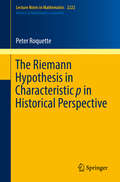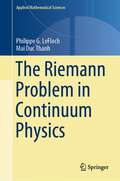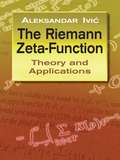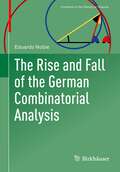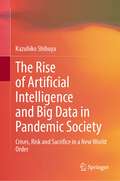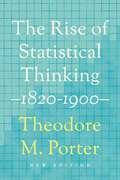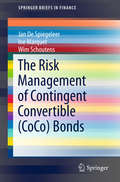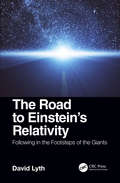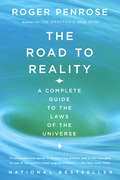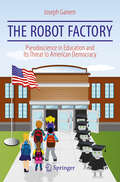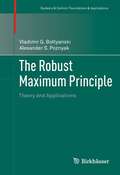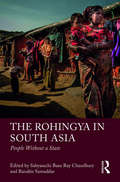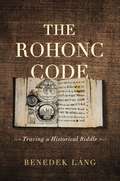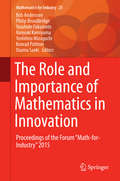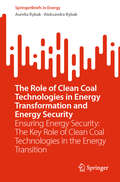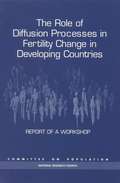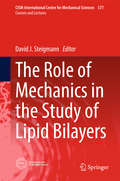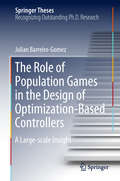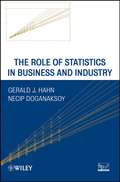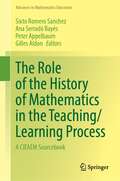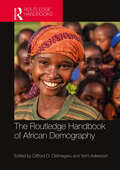- Table View
- List View
The Riemann Hypothesis for Function Fields
by Machiel Van FrankenhuijsenThis book provides a lucid exposition of the connections between non-commutative geometry and the famous Riemann Hypothesis, focusing on the theory of one-dimensional varieties over a finite field. The reader will encounter many important aspects of the theory, such as Bombieri's proof of the Riemann Hypothesis for function fields, along with an explanation of the connections with Nevanlinna theory and non-commutative geometry. The connection with non-commutative geometry is given special attention, with a complete determination of the Weil terms in the explicit formula for the point counting function as a trace of a shift operator on the additive space, and a discussion of how to obtain the explicit formula from the action of the idele class group on the space of adele classes. The exposition is accessible at the graduate level and above, and provides a wealth of motivation for further research in this area.
The Riemann Hypothesis in Characteristic p in Historical Perspective (Lecture Notes in Mathematics #2222)
by Peter RoquetteThis book tells the story of the Riemann hypothesis for function fields (or curves) starting with Artin's 1921 thesis, covering Hasse's work in the 1930s on elliptic fields and more, and concluding with Weil's final proof in 1948. The main sources are letters which were exchanged among the protagonists during that time, found in various archives, mostly the University Library in Göttingen. The aim is to show how the ideas formed, and how the proper notions and proofs were found, providing a particularly well-documented illustration of how mathematics develops in general. The book is written for mathematicians, but it does not require any special knowledge of particular mathematical fields.
The Riemann Hypothesis: The Greatest Unsolved Problem in Mathematics
by Karl SabbaghHistorical discussion of the still unsolved problem of the Riemann Hypothesis.
The Riemann Problem in Continuum Physics (Applied Mathematical Sciences #219)
by Philippe G. LeFloch Mai Duc ThanhThis monograph provides a comprehensive study of the Riemann problem for systems of conservation laws arising in continuum physics. It presents the state-of-the-art on the dynamics of compressible fluids and mixtures that undergo phase changes, while remaining accessible to applied mathematicians and engineers interested in shock waves, phase boundary propagation, and nozzle flows. A large selection of nonlinear hyperbolic systems is treated here, including the Saint-Venant, van der Waals, and Baer-Nunziato models. A central theme is the role of the kinetic relation for the selection of under-compressible interfaces in complex fluid flows. This book is recommended to graduate students and researchers who seek new mathematical perspectives on shock waves and phase dynamics.
The Riemann Zeta-Function: Theory and Applications (Dover Books on Mathematics)
by Aleksandar IvicThis extensive survey presents a comprehensive and coherent account of Riemann zeta-function theory and applications. Starting with elementary theory, it examines exponential integrals and exponential sums, the Voronoi summation formula, the approximate functional equation, the fourth power moment, the zero-free region, mean value estimates over short intervals, higher power moments, and omega results. Additional topics include zeros on the critical line, zero-density estimates, the distribution of primes, the Dirichlet divisor problem and various other divisor problems, and Atkinson's formula for the mean square. End-of-chapter notes supply the history of each chapter's topic and allude to related results not covered by the book. 1985 edition.
The Rise and Fall of Business Firms: A Stochastic Framework on Innovation, Creative Destruction and Growth
by S. V. Buldyrev F. Pammolli M. Riccaboni H. E. StanleyAt the intersection between statistical physics and rigorous econometric analysis, this powerful new framework sheds light on how innovation and competition shape the growth and decline of companies and industries. Analyzing various sources of data including a unique micro level database which collects historic data on the sales of more than 3,000 firms and 50,000 products in 20 countries, the authors introduce and test a model of innovation and proportional growth, which relies on minimal assumptions and accounts for the empirically observed regularities. Through a combination of extensive stochastic simulations and statistical tests, the authors investigate to what extent their simple assumptions are falsified by empirically observable facts. Physicists looking for application of their mathematical and modelling skills to relevant economic problems as well as economists interested in the explorative analysis of extensive data sets and in a physics-orientated way of thinking will find this book a key reference.
The Rise and Fall of the German Combinatorial Analysis (Frontiers in the History of Science)
by Eduardo NobleThis text presents the ideas of a particular group of mathematicians of the late 18th century known as “the German combinatorial school” and its influence. The book tackles several questions concerning the emergence and historical development of the German combinatorial analysis, which was the unfinished scientific research project of that group of mathematicians. The historical survey covers the three main episodes in the evolution of that research project: its theoretical antecedents (which go back to the innovative ideas on mathematical analysis of the late 17th century) and first formulation, its consolidation as a foundationalist project of mathematical analysis, and its dissolution at the beginning of the 19th century. In addition, the book analyzes the influence of the ideas of the combinatorial school on German mathematics throughout the 19th century.
The Rise of Artificial Intelligence and Big Data in Pandemic Society: Crises, Risk and Sacrifice in a New World Order
by Kazuhiko ShibuyaThis book presents a study of the COVID-19 pandemic using computational social scientific analysis that draws from, and employs, statistics and simulations. Combining approaches in crisis management, risk assessment and mathematical modelling, the work also draws from the philosophy of sacrifice and futurology. It makes an original contribution to the important issue of the stability of society by highlighting two significant factors: the COVID-19 crisis as a catalyst for change and the rise of AI and Big Data in managing society. It also emphasizes the nature and importance of sacrifices and the role of politics in the distribution of sacrifices. The book considers the treatment of AI and Big Data and their use to both “good” and “bad” ends, exposing the inevitability of these tools being used. Relevant to both policymakers and social scientists interested in the influence of AI and Big Data on the structure of society, the book re-evaluates the ways we think of lifestyles, economic systems and the balance of power in tandem with digital transformation.
The Rise of Statistical Thinking, 1820–1900
by Theodore M. PorterAn essential work on the origins of statisticsThe Rise of Statistical Thinking, 1820–1900 explores the history of statistics from the field's origins in the nineteenth century through to the factors that produced the burst of modern statistical innovation in the early twentieth century. Theodore Porter shows that statistics was not developed by mathematicians and then applied to the sciences and social sciences. Rather, the field came into being through the efforts of social scientists, who saw a need for statistical tools in their examination of society. Pioneering statistical physicists and biologists James Clerk Maxwell, Ludwig Boltzmann, and Francis Galton introduced statistical models to the sciences by pointing to analogies between their disciplines and the social sciences. A new preface by the author looks at how the book has remained relevant since its initial publication, and considers the current place of statistics in scientific research.
The Risk Management of Contingent Convertible (SpringerBriefs in Finance)
by Jan De Spiegeleer Wim Schoutens Ine Marquet<p>This book provides an overview of the risk components of CoCo bonds. CoCos are hybrid financial instruments that convert into equity or suffer a write-down of the face value upon the appearance of a trigger event. The loss-absorption mechanism is automatically enforced either via the breaching of a particular accounting ratio, typically in terms of the Common Equity Tier 1 (CET1) ratio, or via a regulatory trigger. <p>CoCos are non-standardised instruments with different loss-absorption and trigger mechanisms. They might also contain additional features such as the cancellation of coupon payments. <p>Different pricing models are discussed in detail. These models use market data such as share prices, CDS levels and implied volatility in order to calculate the theoretical price of a CoCo bond and its sensitivities, providing the investor with insides to hedge from adverse changes in the market conditions. <p>The audience are professionals as well as academics who want to learn how to risk manage CoCo bonds using cutting edge techniques as well as all the risk involved in CoCo bonds.</p>
The Road to Einstein's Relativity: Following in the Footsteps of the Giants
by David LythCHOICE Highly Recommended Title, August 2019 <P><P>Expertly guided by renowned cosmologist Dr. David Lyth, learn about the pioneering scientists whose work provided the foundation for Einstein’s formulation of his theories of relativity, and about Einstein's groundbreaking life and work as well. <P><P>This highly readable and accessible panorama of the field delicately balances history and science as it takes the reader on an adventure through the centuries. Without complex mathematics or scientific formulae, this book will be of interest to all, even those without a scientific background, who are intrigued to find out more about what paved the way for one of our most famous physicists to push the boundaries of physics to new lengths. <P><P>Features: <li>Written by an internationally renowned physicist and cosmologist <li>Describes the life and times of Einstein and his important predecessors <li>Focuses on one of the most famous areas of science, Einstein’s Relativity Theory
The Road to Reality: A Complete Guide to the Laws of the Universe
by Roger PenroseFrom one of our greatest living scientists, a magnificent book that provides, for the serious lay reader, the most comprehensive and sophisticated account we have yet had of the physical universe and the essentials of its underlying mathematical theory.Since the earliest efforts of the ancient Greeks to find order amid the chaos around us, there has been continual accelerated progress toward understanding the laws that govern our universe. And the particularly important advances made by means of the revolutionary theories of relativity and quantum mechanics have deeply altered our vision of the cosmos and provided us with models of unprecedented accuracy. What Roger Penrose so brilliantly accomplishes in this book is threefold. First, he gives us an overall narrative description of our present understanding of the universe and its physical behaviors–from the unseeable, minuscule movement of the subatomic particle to the journeys of the planets and the stars in the vastness of time and space.Second, he evokes the extraordinary beauty that lies in the mysterious and profound relationships between these physical behaviors and the subtle mathematical ideas that explain and interpret them. Third, Penrose comes to the arresting conclusion–as he explores the compatibility of the two grand classic theories of modern physics–that Einstein’s general theory of relativity stands firm while quantum theory, as presently constituted, still needs refashioning.Along the way, he talks about a wealth of issues, controversies, and phenomena; about the roles of various kinds of numbers in physics, ideas of calculus and modern geometry, visions of infinity, the big bang, black holes, the profound challenge of the second law of thermodynamics, string and M theory, loop quantum gravity, twistors, and educated guesses about science in the near future. In The Road to Reality he has given us a work of enormous scope, intention, and achievement–a complete and essential work of science
The Robot Factory: Pseudoscience In Education And Its Threat To American Democracy
by Joseph GanemThis book exposes a disturbing misuse of the scientific method to advance policies and agendas that are in fact detrimental to both science and education. The author, a physics professor, examines two related trends in education – the practice of “data-driven” reform and the disparaging of the traditional liberal arts in favor of programs with a heavy emphasis on science and technology. Many of the reforms being foisted on educators have more in common with pseudo-science than real science. The reduction of education to a commodity, and the shilling of science as a means to enhance corporate profits, lead to an impoverished and stunted understanding of science in particular, and of education in general.How is it possible for: • schools with all students learning at grade-level to be rated as failing?• teachers to be rated as ineffective after all their students meet their learning outcomes?• rising grade-school math standards to result in more college students needing remedial math?• politicians to disparage scientists and their results but argue that more students should study science?These bizarre outcomes have happened and are the result of an education system that misuses and misrepresents math and science in the classroom and in crafting education policies. This book exposes the flawed and fallacious thinking that is damaging education at all levels throughout the United States, and makes a compelling case for rethinking the standardized, optimized, and quantified approaches in vogue in education today to accommodate the different needs of individual teachers and students.
The Robust Maximum Principle: Foundations And Applications: Robust Maximum Principle: Theory And Applications (Systems And Control: Foundations And Applications Ser.)
by Vladimir G. Boltyanski Alexander S. PoznyakCovering some of the key areas of optimal control theory (OCT), a rapidly expanding field, the authors use new methods to set out a version of OCT's more refined 'maximum principle.' The results obtained have applications in production planning, reinsurance-dividend management, multi-model sliding mode control, and multi-model differential games. This book explores material that will be of great interest to post-graduate students, researchers, and practitioners in applied mathematics and engineering, particularly in the area of systems and control.
The Rohingya in South Asia: People Without a State
by Ranabir Samaddar Sabyasachi Basu Ray ChaudhuryThe Rohingya of Myanmar are one of the world’s most persecuted minority populations without citizenship. After the latest exodus from Myanmar in 2017, there are now more than half a million Rohingya in Bangladesh living in camps, often in conditions of abject poverty, malnutrition and without proper access to shelter or work permits. Some of them are now compelled to take to the seas in perilous journeys to the Southeast Asian countries in search of a better life. They are now asked to go back to Myanmar, but without any promise of citizenship or an end to discrimination. This book looks at the Rohingya in the South Asian region, primarily India and Bangladesh. It explores the broader picture of the historical and political dimensions of the Rohingya crisis, and examines subjects of statelessness, human rights and humanitarian protection of these victims of forced migration. Further, it chronicles the actual process of emergence of a stateless community – the transformation of a national group into a stateless existence without basic rights.
The Rohonc Code: Tracing a Historical Riddle
by Benedek LángFirst discovered in a Hungarian library in 1838, the Rohonc Codex keeps privileged company with some of the most famous unsolved writing systems in the world, notably the Voynich manuscript, the Phaistos Disk, and Linear A. Written entirely in cipher, this 400-year-old, 450-page-long, richly illustrated manuscript initially gained considerable attention but was later dismissed as an apparent forgery. No serious scholar would study it again until the turn of the twenty-first century. This engaging narrative follows historian Benedek Láng’s search to uncover the truth about this thoroughly mysterious book that has puzzled dozens of codebreakers. Láng surveys the fascinating theories associated with the Codex and discusses possible interpretations of the manuscript as a biblical commentary, an apocryphal gospel, or a secret book written for and by a sect. He provides an overview of the secret writing systems known in early modern times and an account of the numerous efforts to create an artificial language or to find a long-lost perfect tongue—endeavors that were especially popular at the time the Codex was made. Lastly, he tests several codebreaking methods in order to decipher the Codex, finally pointing to a possible solution to the enigma of its content and language system.Engagingly written, academically grounded, and thoroughly compelling, The Rohonc Code will appeal to historians, scholars, and lay readers interested in mysteries, codes, and ciphers.
The Rohonc Code: Tracing a Historical Riddle
by Benedek LángFirst discovered in a Hungarian library in 1838, the Rohonc Codex keeps privileged company with some of the most famous unsolved writing systems in the world, notably the Voynich manuscript, the Phaistos Disk, and Linear A. Written entirely in cipher, this 400-year-old, 450-page-long, richly illustrated manuscript initially gained considerable attention but was later dismissed as an apparent forgery. No serious scholar would study it again until the turn of the twenty-first century. This engaging narrative follows historian Benedek Láng’s search to uncover the truth about this thoroughly mysterious book that has puzzled dozens of codebreakers. Láng surveys the fascinating theories associated with the Codex and discusses possible interpretations of the manuscript as a biblical commentary, an apocryphal gospel, or a secret book written for and by a sect. He provides an overview of the secret writing systems known in early modern times and an account of the numerous efforts to create an artificial language or to find a long-lost perfect tongue—endeavors that were especially popular at the time the Codex was made. Lastly, he tests several codebreaking methods in order to decipher the Codex, finally pointing to a possible solution to the enigma of its content and language system.Engagingly written, academically grounded, and thoroughly compelling, The Rohonc Code will appeal to historians, scholars, and lay readers interested in mysteries, codes, and ciphers.
The Role and Importance of Mathematics in Innovation
by Bob Anderssen Philip Broadbridge Yasuhide Fukumoto Naoyuki Kamiyama Yoshihiro Mizoguchi Konrad Polthier Osamu SaekiThis book is a collection of papers presented at the "Forum Math-for-Industry 2015" for which the unifying theme was "The Role and Importance of Mathematics in Innovation", held at the Institute of Mathematics for Industry, Kyushu University, October 26-30, 2015. The theme highlights two key roles that mathematics plays in supporting innovation in science, technology, and daily life, namely, needs-based and idea-based. For the former, mathematics assists with sorting through the possibilities and putting matters on a more rigorous foundation, and for the latter, mathematical models of the possible implementations play a key role. The book gives excellent examples of how mathematics assists with stimulating innovation and, thereby, highlights the importance and relevance of the concept Mathematics_FOR_Industry. The contents of this volume address productive and successful interaction between industry and mathematicians, as well as the cross-fertilization and collaboration that result when mathematics is involved with the advancement of science and technology.
The Role of Clean Coal Technologies in Energy Transformation and Energy Security: Ensuring Energy Security: The Key Role of Clean Coal Technologies in the Energy Transition (SpringerBriefs in Energy)
by Aurelia Rybak Aleksandra RybakThis book presents the latest achievements in the field of clean coal technologies and shows how these innovations contribute to environmental protection and ensure stability of energy supplies. The book describes how clean coal technologies can revolutionize our energy future. From advanced mining methods to modern energy storage solutions, this book is a source of knowledge about sustainable development and technological innovation.
The Role of Diffusion Processes in Fertility Change in Developing Countries: Report Of A Workshop
by Committee on PopulationThe National Academies Press (NAP)--publisher for the National Academies--publishes more than 200 books a year offering the most authoritative views, definitive information, and groundbreaking recommendations on a wide range of topics in science, engineering, and health. Our books are unique in that they are authored by the nation's leading experts in every scientific field.
The Role of Mechanics in the Study of Lipid Bilayers (CISM International Centre for Mechanical Sciences #577)
by David J. SteigmannThis book is the first collection of lipid-membrane research conducted by leading mechanicians and experts in continuum mechanics. It brings the overall intellectual framework afforded by modern continuum mechanics to bear on a host of challenging problems in lipid membrane physics. These include unique and authoritative treatments of differential geometry, shape elasticity, surface flow and diffusion, interleaf membrane friction, phase transitions, electroelasticity and flexoelectricity, and computational modelling.
The Role of Population Games in the Design of Optimization-Based Controllers: A Large-scale Insight (Springer Theses)
by Julian Barreiro-GomezThis book reports on the implementation of evolutionary-game theory in the design of distributed optimization-based controllers. First, it discusses how the classical population-game approach can contribute to and complement the design of optimization-based controllers. It shows how the features of this approach can be exploited to extend their capabilities in the solution of distributed optimization problems, and examines density games in order to consider multiple coupled constraints and preserve the non-centralized information requirements. Furthermore, it establishes a close relationship between the possible interactions among agents in a population with constrained information sharing among different local controllers. It also discusses coalitional games, focusing on the Shapley power index and proposes an alternative method of computing the latter, which reduces computational time, as well as a different way of finding it using distributed communication structures. All the proposed strategies are then tested on various control problems, such as those related to the Barcelona water supply network, multiple continuous stirred tank reactors, various unmanned aerial vehicle systems, and a water distribution system. This thesis, examined at the Universitat Politècnica de Catalunya and Universidad de los Andes in 2017, received the award for best thesis in control from the control group of the Spanish Committee of Automatic Control (CEA) in the same year.
The Role of Statistics in Business and Industry
by Necip Doganaksoy Gerald J. HahnAn insightful guide to the use of statistics for solving key problems in modern-day business and industry This book has been awarded the Technometrics Ziegel Prize for the best book reviewed by the journal in 2010. Technometrics is a journal of statistics for the physical, chemical and engineering sciences, published jointly by the American Society for Quality and the American Statistical Association. Criteria for the award include that the book brings together in one volume a body of material previously only available in scattered research articles and having the potential to significantly improve practice in engineering and science. Highlighting the relevance of statistical methods in everyday applications, The Role of Statistics in Business and Industry bridges the gap between the tools of statistics and their use in today's business world. This one-of-a-kind resource encourages the proactive use of statistics in three well-organized and succinct parts: Setting the Stage provides an introduction to statistics, with a general overview of its uses in business and industry Manufactured Product Applications explains how statistical techniques assist in designing, building, improving, and ensuring the reliability of a wide variety of manufactured products such as appliances, plastic materials, aircraft engines, and locomotives Other Applications describe the role of statistics in pharmaceuticals, finance, and business services, as well as more specialized areas including the food, semiconductor, and communications industries This book is truly unique in that it first describes case studies and key business problems, and then shows how statistics is used to address them, while most literature on the topic does the reverse. This approach provides a comprehensive understanding of common issues and the most effective methods for their treatment. Each chapter concludes with general questions that allow the reader to test their understanding of the presented statistical concepts as well as technical questions that raise more complex issues. An extensive FTP site provides additional material, including solutions to some of the applications. With its accessible style and real-world examples, The Role of Statistics in Business and Industry is a valuable supplement for courses on applied statistics and statistical consulting at the upper-undergraduate and graduate levels. It is also an ideal resource for early-career statisticians and practitioners who would like to learn the value of applying statistics to their everyday work.
The Role of the History of Mathematics in the Teaching/Learning Process: A CIEAEM Sourcebook (Advances in Mathematics Education)
by Gilles Aldon Peter Appelbaum Sixto Romero Sanchez Ana Serradó BayésThis volume presents multiple perspectives on the uses of the history of mathematics for teaching and learning, including the value of historical topics in challenging mathematics tasks, for provoking teachers’ reflection on the nature of mathematics, curriculum development questions that mirror earlier pedagogical choices in the history of mathematics education, and the history of technological innovations in the teaching and learning of mathematics. An ethnomathematical perspective on the history of mathematics challenges readers to appreciate the role of mathematics in perpetuating consequences of colonialism. Histories of the textbook and its uses offer interesting insights into how technology has changed the fundamental role of curriculum materials and classroom pedagogies. History is explored as a source for the training of teachers, for good puzzles and problems, and for a broad understanding of mathematics education policy. Third in a series of sourcebooks from the International Commission for the Study and Improvement of Mathematics Teaching, this collection of cutting-edge research, stories from the field, and policy implications is a contemporary and global perspective on current possibilities for the history of mathematics for mathematics education. This latest volume integrates discussions regarding history of mathematics, history of mathematics education and history of technology for education that have taken place at the Commission's recent annual conferences.
The Routledge Handbook of African Demography
by Clifford O. Odimegwu Yemi AdewoyinThis handbook provides an authoritative and comprehensive overview of African population dynamics, variations, causes and consequences, demonstrating the real-world applications of research in policies and programmes.African demography has come of age. Over 50 years, the discipline has grown exponentially in the number of training and research institutions, specialist experts and academic output, all with an aim of addressing the enormous demographic challenges faced by the continent. The book draws on old and emerging analytical tools to explore the relationships between population dynamics and social, economic, cultural and political environments from African perspectives. Key topics include fertility, sexual behaviours, healthcare, ageing, mortality, migration, displacement, the causes and consequences of demographic changes and teaching and research developments in African demography.The Routledge Handbook of African Demography will be an essential resource for students and researchers of African demography, sociology, development and cultural studies.

